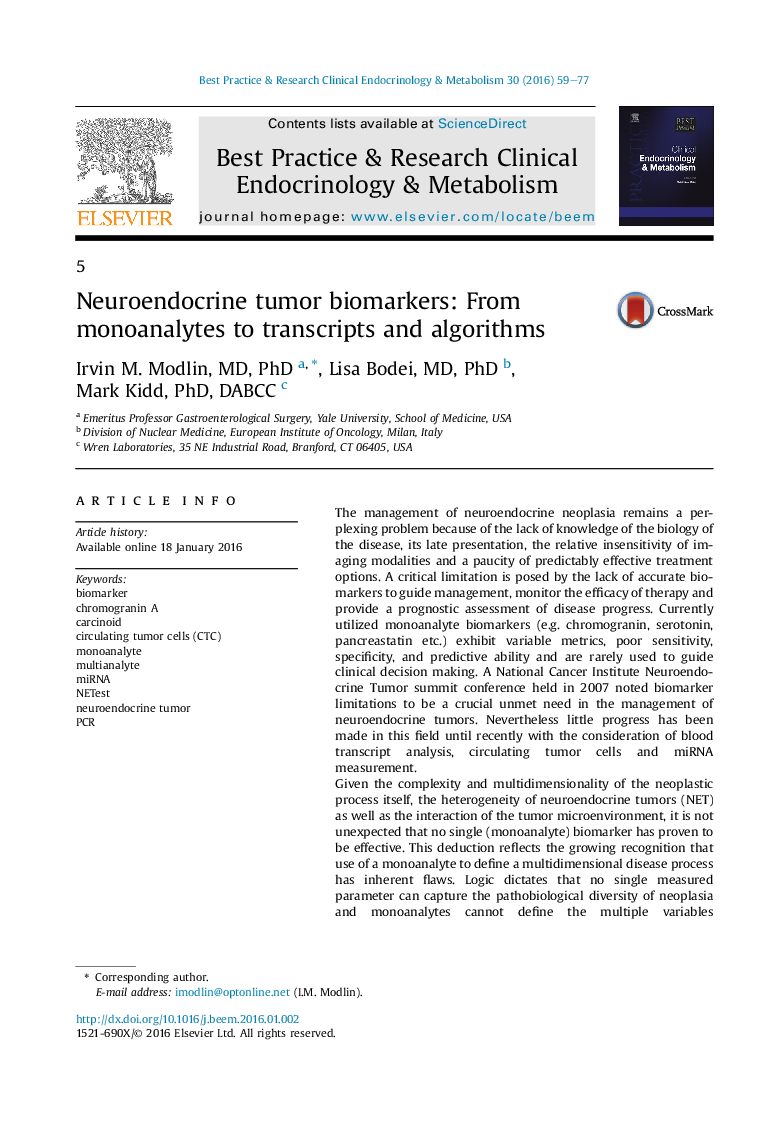| کد مقاله | کد نشریه | سال انتشار | مقاله انگلیسی | نسخه تمام متن |
|---|---|---|---|---|
| 2791538 | 1154954 | 2016 | 19 صفحه PDF | دانلود رایگان |

The management of neuroendocrine neoplasia remains a perplexing problem because of the lack of knowledge of the biology of the disease, its late presentation, the relative insensitivity of imaging modalities and a paucity of predictably effective treatment options. A critical limitation is posed by the lack of accurate biomarkers to guide management, monitor the efficacy of therapy and provide a prognostic assessment of disease progress. Currently utilized monoanalyte biomarkers (e.g. chromogranin, serotonin, pancreastatin etc.) exhibit variable metrics, poor sensitivity, specificity, and predictive ability and are rarely used to guide clinical decision making. A National Cancer Institute Neuroendocrine Tumor summit conference held in 2007 noted biomarker limitations to be a crucial unmet need in the management of neuroendocrine tumors. Nevertheless little progress has been made in this field until recently with the consideration of blood transcript analysis, circulating tumor cells and miRNA measurement.Given the complexity and multidimensionality of the neoplastic process itself, the heterogeneity of neuroendocrine tumors (NET) as well as the interaction of the tumor microenvironment, it is not unexpected that no single (monoanalyte) biomarker has proven to be effective. This deduction reflects the growing recognition that use of a monoanalyte to define a multidimensional disease process has inherent flaws. Logic dictates that no single measured parameter can capture the pathobiological diversity of neoplasia and monoanalytes cannot define the multiple variables (proliferation, metabolic activity, invasive potential and metastatic propensity) that constitute tumor growth.Thus far, most biomarkers whether in tissue or blood/urine have been single analytes with varying degrees of sensitivity and specificity and in general have failed to exhibit robust metrics or lacked methodological rigor. Neuroendocrine (NE) disease represents an area of biomarker paucity since the individual biomarkers (gastrin, insulin etc) are not widely applicable to the diverse types of NE neoplasia (NEN). Broad spectrum markers such as CgA have limitations in sensitivity, specificity and reproducibility.This review serves to provide a general background of the evolution of NET biomarkers. It provides an assessment of their current and past usage and limitations in assessing their diagnostic, pathologic and prognostic aspects in respect of NET. It provides a view of the changing methodology of biomarker development and the application of biomathematical analyses to redefining detection and treatment. Finally, it presents a description and consensus on current advances in transcript analysis, miRNA measurement and circulating tumor cell identification.
Journal: Best Practice & Research Clinical Endocrinology & Metabolism - Volume 30, Issue 1, January 2016, Pages 59–77